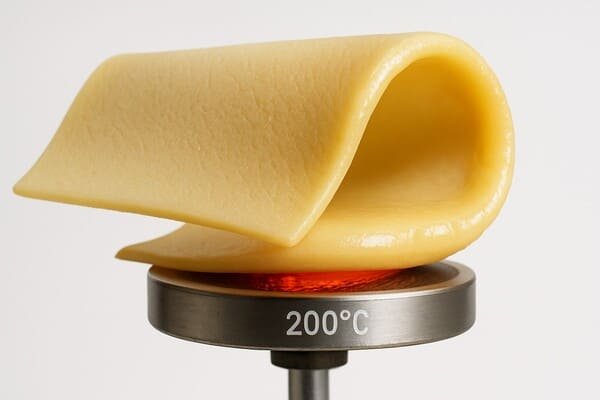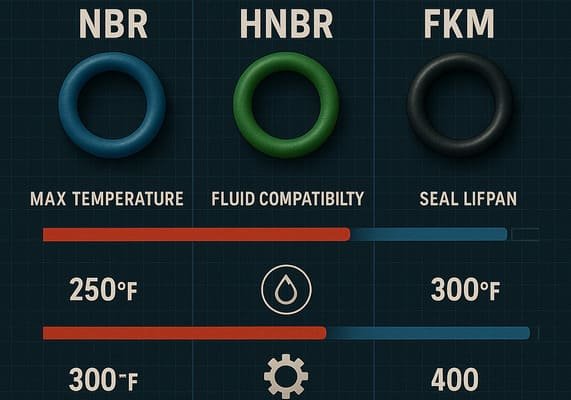Rubber is known for its elasticity and durability, but what happens when it’s exposed to extreme heat? Let’s uncover the melting point of rubber and the factors that influence it.
The melting point of rubber depends on its type. Natural rubber melts at around 200°C (392°F), while synthetic rubbers can melt at different temperatures, typically between 180°C (356°F) and 250°C (482°F).

The melting point of rubber1 is not a fixed number—different types of rubber behave differently under heat. Let’s explore the melting points of various rubber types and factors that affect them.
What Affects the Melting Point of Rubber?
Rubber’s melting point can vary widely, but why? Let’s explore the factors that influence its behavior at high temperatures.
Several factors, such as the rubber's composition, additives, and cross-linking2, can influence its melting point. Understanding these elements is key to choosing the right rubber for heat-sensitive applications.
The type of rubber itself plays a significant role in determining the melting point. Natural rubber (NR) typically melts around 200°C, while synthetic rubbers like Styrene-Butadiene Rubber (SBR) and Nitrile Rubber (NBR) have varying melting points depending on their chemical composition. The addition of fillers, plasticizers, or curing agents can also change the melting point. For instance, vulcanized rubber3, which undergoes a chemical process to improve strength and elasticity, tends to have a higher melting point than non-vulcanized rubber.
Rubber Types and Their Melting Points
| Rubber Type | Melting Point Range4 | Key Characteristics5 |
|---|---|---|
| Natural Rubber (NR) | 190-210°C (374-410°F) | High elasticity6, excellent tensile strength7 |
| Styrene-Butadiene Rubber8 (SBR) | 180-220°C (356-428°F) | Common in tires, wear-resistant8 |
| Nitrile Rubber (NBR)9 | 200-250°C (392-482°F) | Oil-resistant10, commonly used for seals |
| EPDM Rubber11 | 250°C (482°F) | Excellent weathering, ozone resistance12 |
The Role of Additives in Rubber13's Melting Point
Additives like plasticizers and fillers14 are often mixed with rubber to modify its properties. While they can improve flexibility, durability, and resistance to environmental factors, they can also lower the rubber's melting point. On the other hand, cross-linking (vulcanization) increases the rubber’s strength and temperature resistance, raising the melting point significantly.
How to Choose the Right Rubber Based on Temperature?
When it comes to selecting rubber for specific applications, temperature is a crucial factor. But how do you choose the right one based on its melting point?
Choosing the right rubber for your application involves considering both the operating temperature and the potential for exposure to high heat. Each rubber type has a melting point that determines its suitability for different environments.

When selecting rubber for industrial applications, knowing the melting point is just one aspect. You also need to consider the environment in which the rubber will be used. For example, automotive components like gaskets and seals need to withstand both high and low temperatures. Nitrile rubber is often chosen for its oil and heat resistance, while EPDM is ideal for high-temperature environments due to its excellent weathering and ozone resistance.
Rubber in Automotive Applications15
In the automotive industry, components like hoses, seals, and gaskets are exposed to extreme conditions. A rubber that melts too quickly could cause leakage or failure, compromising the system. Therefore, understanding the operating temperature range of rubber helps prevent early degradation and ensures long-lasting performance.
Rubber for Industrial Applications16
For industrial use, rubbers like silicone and EPDM are often chosen for their resistance to both high and low temperatures. Silicone rubber, for instance, has a melting point higher than many other rubbers, making it ideal for high-temperature gaskets and seals.
| Application Type | Ideal Rubber Type | Melting Point Range |
|---|---|---|
| Automotive Seals17 | Nitrile, EPDM | 180-250°C (356-482°F) |
| Industrial Gaskets18 | Silicone, EPDM | 250-300°C (482-572°F) |
| Food Processing Seals19 | Silicone | 250°C (482°F) |
Can Rubber Be Recycled After Melting?
Once rubber reaches its melting point, can it be recycled or reused? Let’s find out what happens after rubber melts and if it can be salvaged.
Once rubber melts, it undergoes a process called “flowing” or “fusing.” While it is technically possible to recycle some types of rubber, the process is often complicated, especially with vulcanized rubber.
Rubber recycling is a challenge, particularly for vulcanized rubber, which is cross-linked and cannot be re-melted in the traditional sense. The melting process breaks the bonds between molecules, and while some types of rubber can be reprocessed, the vulcanization process makes it difficult to recycle. Non-vulcanized rubber, such as thermoplastic elastomers (TPE), can be more easily reprocessed and reused, as they can be re-melted and molded into new shapes.
Rubber Recycling20 in the Automotive Industry
In automotive applications, recycling rubber can reduce waste. However, due to the vulcanization process, the reuse of rubber from tires and seals can be challenging. Some companies have developed techniques to break down the rubber into smaller components, making it easier to recycle and reuse.
Alternative Methods of Rubber Disposal21
For vulcanized rubber, companies often use processes like pyrolysis to break it down into usable components such as carbon black and oil, which can then be used for other products.
Conclusion
Rubber's melting point depends on its type and the additives used. By understanding these factors, you can make informed choices for applications that require heat-resistant materials.
-
Understanding the melting point of rubber is crucial for selecting the right type for heat-sensitive applications. Explore this link for detailed insights. ↩
-
Exploring the role of cross-linking in rubber can provide insights into its strength and temperature resistance, crucial for various applications. ↩
-
Learning about vulcanized rubber's properties and recycling challenges can help you make informed decisions for sustainable practices in rubber use. ↩
-
Understanding melting point range is crucial for selecting the right rubber for specific applications, ensuring durability and performance. ↩
-
Exploring the key characteristics helps in making informed decisions about rubber selection for various applications. ↩
-
Exploring this resource will deepen your understanding of how high elasticity enhances rubber performance in various applications. ↩
-
Understanding tensile strength is crucial for selecting materials in engineering and manufacturing, ensuring safety and performance. ↩
-
Explore this link to understand SBR's unique properties and its vital role in various industries, especially in tire manufacturing. ↩ ↩
-
Explore this link to understand Nitrile Rubber's unique properties and its critical applications in various industries. ↩
-
Explore this resource to understand the best oil-resistant rubbers, their properties, and applications in various industries. ↩
-
Explore this link to understand EPDM rubber's unique properties and its critical role in various industries, especially automotive. ↩
-
Exploring this resource will deepen your understanding of ozone resistance and its critical role in enhancing rubber durability. ↩
-
Learn how additives can enhance or alter rubber properties, impacting its performance in different environments. ↩
-
Explore this resource to understand how plasticizers and fillers can enhance or compromise rubber performance. ↩
-
Understanding rubber types used in automotive applications ensures safety and reliability in vehicle components. ↩
-
Explore the best rubber types for industrial use to enhance performance and longevity in demanding environments. ↩
-
Explore this resource to understand the ideal materials for automotive seals, ensuring durability and performance in extreme conditions. ↩
-
Explore this resource to discover the ideal materials for industrial gaskets, ensuring durability and performance in various applications. ↩
-
Explore this link to discover the ideal materials for food processing seals, ensuring safety and compliance in your applications. ↩
-
Find out the complexities of rubber recycling and how it impacts sustainability in the rubber industry. ↩
-
Learn about innovative disposal methods that can help reduce waste and promote recycling in the rubber industry. ↩








